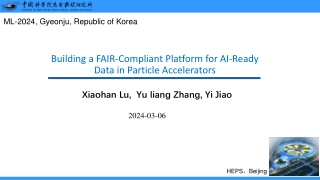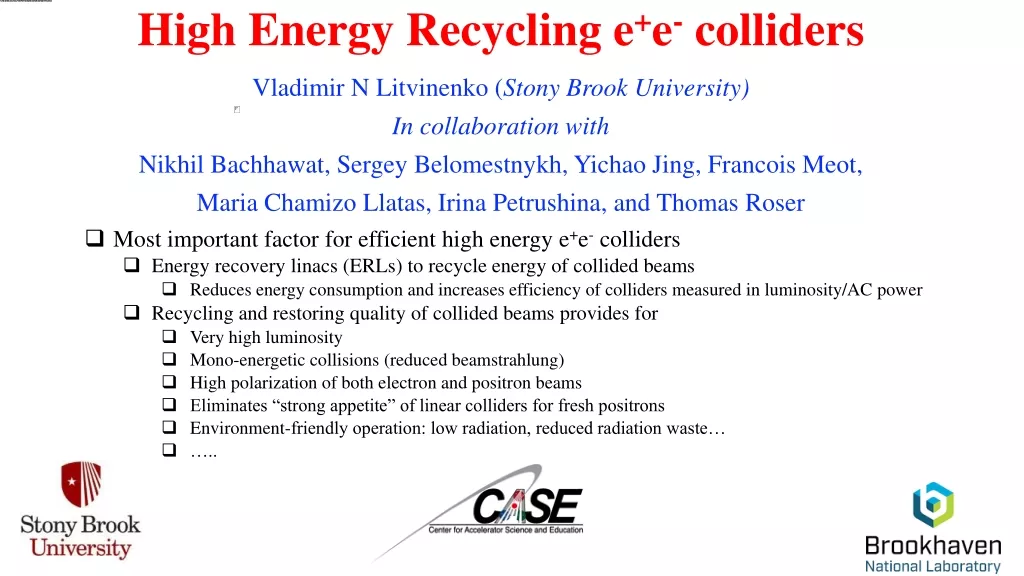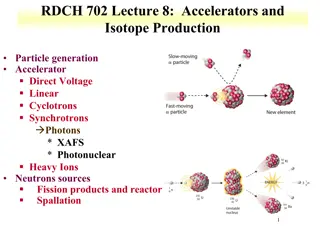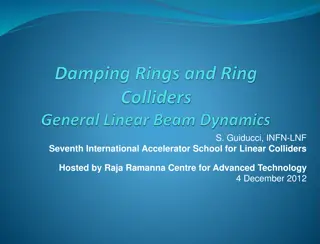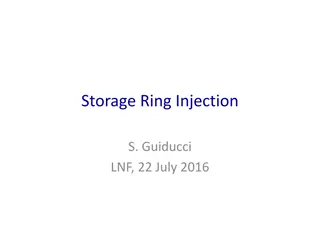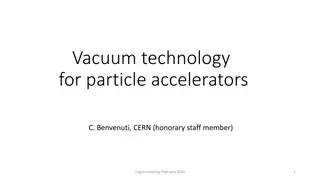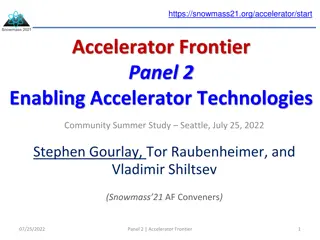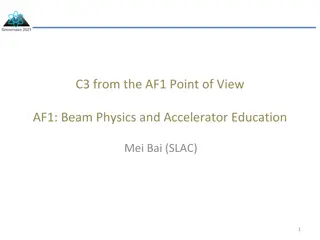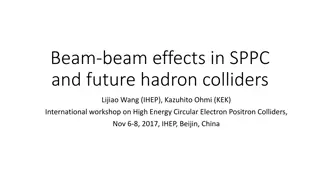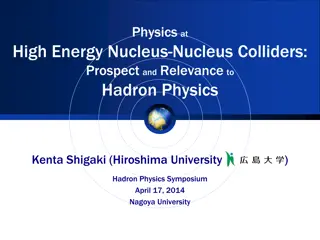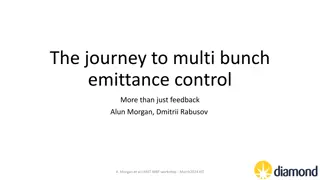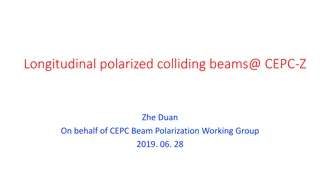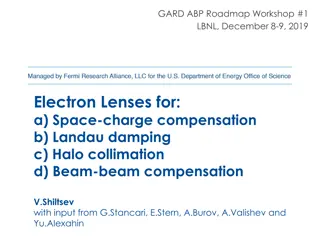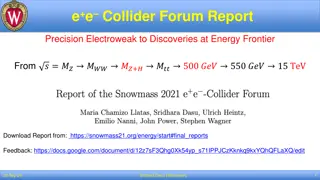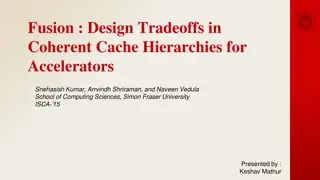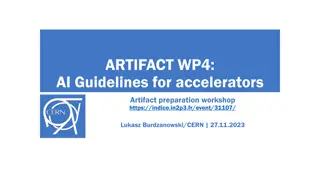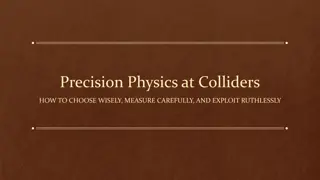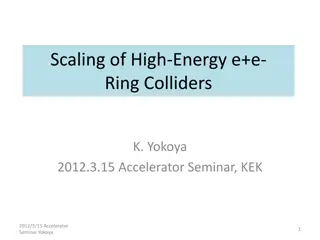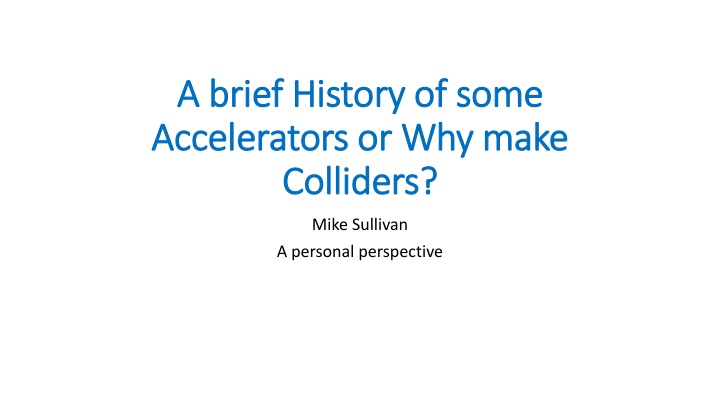
History of Accelerators and Colliders: A Personal Perspective
The early history of accelerators and colliders from Rutherford's team to present-day technologies. Discover the significance of fixed target colliders, mysterious beams of the time, and the first collider experiment.
Download Presentation

Please find below an Image/Link to download the presentation.
The content on the website is provided AS IS for your information and personal use only. It may not be sold, licensed, or shared on other websites without obtaining consent from the author. If you encounter any issues during the download, it is possible that the publisher has removed the file from their server.
You are allowed to download the files provided on this website for personal or commercial use, subject to the condition that they are used lawfully. All files are the property of their respective owners.
The content on the website is provided AS IS for your information and personal use only. It may not be sold, licensed, or shared on other websites without obtaining consent from the author.
E N D
Presentation Transcript
A brief History of some A brief History of some Accelerators or Why make Accelerators or Why make Colliders? Colliders? Mike Sullivan A personal perspective
Outline Outline The first collider experiment Cosmic rays Some early accelerators Matter anti-matter colliders Present day colliders Future designs Summary and conclusions
Early history Early history I consider the Rutherford team of Geiger and Marsden to have put together the first fixed target collider in 1909-1913 They had a radioactive source (mostly Bismuth 214 and Radon 222 emitters) for a beam and the fixed target was a thin sheet of Au The theory of atoms at that time was that the electrons (already discovered by J.J. Thomson in 1897 which explained what cathode rays were) were sort of stuck inside an atomic sized sphere of positive charge raisins in a plum pudding This model of matter predicted that the heavy, positively charged particles would fly right through with little or no deflection
Aside about the mysterious beams of the time Aside about the mysterious beams of the time In 1899-1900 scientists were discovering several different rays or beams that came from radioactive decay They classified them by their penetrating ability In 1900 the ray was identified with the recently discovered electron In 1907 the ray was identified with He, but it was not yet known to be a nucleus rays were finally identified as photons in 1914 Paper sheet Thin aluminum Pb From Wikipedia Alpha radiation consists of helium nuclei and is readily stopped by a sheet of paper. Beta radiation, consisting of electrons or positrons, is stopped by a thin aluminum plate, but gamma radiation requires shielding by dense material such as lead or concrete
S First collider cont. First collider cont. Marsden was the grad student who had to look for the scattered particles Marsden s eye was the particle detector There was a scintillation counter (S) just in front of the microscope The chamber had to be evacuated New technology at the time The scintillation light from the was faint and very hard to see Marsden ended up detecting particles backscattering almost right back into the source One of Geiger and Marsden's apparatuses Alpha particles (from R) scatter off the foil (F). The microscope (M) is rotated around the cylindrical box (B) to count scattering at any angle www.cambrigdephysics.org
Rutherford experiment was a forerunner Rutherford experiment was a forerunner Marsden also found that very few particles would backscatter Famous quote from Rutherford like seeing the shell from a 15 in. cannon bouncing back from a sheet of paper Rutherford concluded from this data that the positive charge in the atom was confined to a very small volume located at the center The nucleus had been discovered Rutherford from then on, was a strong advocate for accelerating particles in order to further study the structure of matter
Next big accelerator (cosmic rays) Next big accelerator (cosmic rays) Although people wanted to accelerate particles and the field did get started the technology was still new, and most attempts were on a very small scale and with very low accelerating energies The discovery of cosmic rays (first in about 1910 and then more clearly in the 20s and 30s) helped to push forward the field of particle physics while accelerator technology continued to improve During this time accelerator technology was mostly static electric field accelerators (i.e. Van de Graaff accelerators and Cockcroft-Walton accelerators) By the early 1940s accelerating energies had reached 1-2 MeV roughly the energy of the radioactive decay particles ( , and ) There is a very interesting book out by A. Sessler and E. Wilson, Engines of Discovery which goes into much more detail about early accelerators and continues on up to the present
The Westinghouse Atom Smasher, the 5 MeV Van de Graaff generator built in 1937 by the Westinghouse Electric company in Forest Hills, Pennsylvania Van de Graaf generator Van de Graaf generator
Cockcroft Cockcroft- -Walton accelerators accelerators Walton A couple of pictures of CW accelerators. These types of accelerators were used into the 1970s as initial accelerators for protons. The picture on the right is from the AGS accelerator at Brookhaven National Laboratory. Typical accelerating energies were 1-2 MeV.
Cosmic rays Cosmic rays The study of cosmic rays dominated the field from about 1920-1940 They did not behave like any of the then known particles The electron had been discovered The positron was found in cosmic ray events in 1932 The proton had been identified as the hydrogen nucleus The particle was now known to be the helium nucleus rays had been identified as high energy photons X-rays were also known to be photons by this time Cosmic rays did not look like any of these (they were too penetrating) The study of cosmic rays generated the birth of particle detector technology We now know that most CRs that make it to the surface are muons They were identified as a new particle in 1936 Famous quote by Isidor Rabi: Who ordered that Cosmic ray detectors also discovered the expected pion In 1935 Yukawa had predicted this particle as an exchange particle for the strong force in the nucleus This was accomplished in 1947 Primary cosmic ray energies are more than 1 GeV (1000 times radioactivity energies) with some now measured to be >1011 GeV (>100 EeV Exa eV)
The cosmic ray The cosmic ray energy spectrum energy spectrum Cosmic rays are still of great interest in the field of astrophysics. Cosmic Rays continue to hold the record for the highest energy particles. There are several theories about how the galaxy might be able to produce such high energy particles. This is a very active and ongoing study and is also teaching us about the very high-energy aspects of parts of our galaxy.
Theoretical aside from Dirac Theoretical aside from Dirac Another very important reason for making and using colliders comes from Dirac In 1928, Dirac constructed a relativistic equation for the motion of the electron However, he found out that the equation also had solutions with the opposite charge than that of the electron He first thought that the proton might be these positive charge solutions but was forced to predict the existence of the positron or, in other words, the existence of anti-matter In 1932, Anderson discovered positrons in cosmic ray events
Anti Anti- -matter matter The existence of anti-matter was first considered just interesting Note: Anti-matter is not what people thought of earlier as negative matter which was matter with negative gravity As far as we know, anti-matter has the same positive gravity of ordinary matter CERN has been able to make anti-hydrogen and is attempting to measure whether or not the gravitational attraction of anti-hydrogen is the same as hydrogen The fact that matter and anti-matter annihilated when they collided with each other did not seem very useful Gradually, as colliding energies got high enough, people came to realize that the annihilation energy could turn back into a new particle anti-particle pair
Early colliders Early colliders Up to and during WWII the field had accelerating machines that generated a beam of particles used to hit a fixed target It wasn t until after the war that the field started to look into making storage rings of colliding beams The war also produced the klystron Colliding beams can produce much higher center-of-mass energies (Ecm) Anti-protons were found at the Bevatron at LBNL in 1955 but accelerating energies were too low to be able to create anti-protons in any reasonable quantity Positrons were much easier to create in the lab and by the end of the 1950s electron beam energies were high enough to produce decent amounts of positrons after hitting a fixed target
Aside about center Aside about center- -of of- -mass mass The amount of energy in the center-of-mass reference frame is the energy available to create a new particle anti-particle pair Quantum mechanics tells us that if the quantum numbers of the particle anti-particle pair annihilation state can match a new particle anti-particle creation state, then the new particle pair can be made if we have enough energy (Anything that can happen does happen) Fixed target colliders can also create new particles but the available energy in the center-of-mass frame is significantly lower
AdA AdA Bruno Touschek was at the Istituto Nazionale di Fisica Nucleare (INFN) in Frascati, near Rome when he proposed building an e+e- collider storage ring in 1960 This was a first: colliding matter against anti- matter Touschek was one of the first to recognize that the energy from the annihilation could become new particles With the team at Frascati, Touschek built and ran Anello di Accumulazione (AdA) an e+e- storage ring This was an amazing machine and the first of a long line of e+e- colliders
Colliders in the 60s Colliders in the 60s There were a few electron-electron colliders in the sixties Stanford Princeton collider (e-e-) (1962) Vacuum scrubbing (photon desorption) was discovered and with it the need for ultra-high vacuum chambers more on this later VEPP-1 (e-e-) (Novosibirsk, Siberia 1964) VEPP-2 (Novosibirsk 1965) These machines still had low beam currents and beam energies and were not matter anti-matter colliders, but storage ring technology improved Proton energy ramping rings or storage rings with strong focusing were also developed Proton Synchrotron at CERN (1959) No proton proton colliders until the 1970s
Colliders in the 70s Colliders in the 70s Matter-antimatter colliders became all the rage in the 70s Dominated by e+e- colliders ADONE at INFN in Frascati (1969) SPEAR at SLAC (1972) VEPP-2M at BINP in Novosibirsk Nov(1974) DORIS at DESY in Hamburg (1974) CERN built and ran the Intersecting Storage Ring (ISR) the first PP collider It operated from 1971 to 1984 Fermilab at Batavia, Illinois was founded in 1969 and started constructing the Tevatron in 1974 which started operation in 1983 The first proton anti-proton collider
The Drell The Drell- -Yan process Yan process In the late 1960s experimental data from the Alternating Gradient Synchrotron (AGS) at BNL revealed some puzzling events The AGS was the highest energy proton machine at that time producing a 33 GeV beam to fixed target experiments The target with the puzzling data was Uranium and the puzzling data was + - pairs Somehow matter (protons) hitting matter (Uranium) was making matter ani- matter pairs In 1970, Drell and Yan came up with the suggestion that there must occasionally be an anti-quark inside the proton that collides with a quark from the other proton annihilating into energy that can then reform back into new particles in this case + -
Drell Drell- -Yan diagram Yan diagram Here we have an anti-parton ( ?) from one proton annihilating with a matter parton (?) from the other proton. One has to account for the different partons as well as the probability of there being an anti-parton of the correct flavor for a given collision. This process can of course make any particle/anti- particle pair if the available energy is high enough. Muon pairs are one of the easiest particle/anti-particle pairs one can spot in a hadron collision because they have opposite signs, and they can go through a lot of material. Pion pairs not doubt were also made but one is not able to separate pion pairs from the multitude of other pions that result from hadron-hadron collisions.
Drell Drell- -Yan (cont.) Yan (cont.) Conclusion: protons (ordinary matter) contain some amount of anti-matter This discovery opened up a new world for colliders PP colliders can now also hunt for new particles Just as this discovery was made, Fermilab was already being built to be the largest proton anti-proton collider A PPbar collision can indeed provide a much larger energy ball for new particle production Unfortunately, making anti-protons is difficult to do efficiently and you want a lot of them In addition, most of the time when the proton and anti-proton collide, they fragment and do not completely annihilate So, the event rate for new particles is very low and the collider needs a very high luminosity collision Nevertheless, the Tevatron did find the Top quark and measured its mass to be 173 GeV more than 10 times above the na ve mass extrapolation value of 15 GeV
Colliders of the 80s Colliders of the 80s The late 1970s and early 1980s saw the continuation of the e+e- colliders PEP (Positron-Electron Project originally the Positron Electron Proton) at SLAC which ran from 1980-1990 at an Ecm of 29 GeV PETRA (Positron-Electron Tandem Ring Accelerator) at DESY in Hamburg ran from 1978 to 1986 with Ecm energy range from 30 GeV to 42 GeV These two colliders were intended to be Top quark factories (15 GeV was the guessed at mass for the Top quark at this time) The KEK laboratory in Tsukuba, Japan was constructed in the 1980s and TRISTAN was the first collider in Japan with an Ecm range of 50 GeV to 61.4 GeV (this was a continuation of the search for the Top quark) This machine confirmed the prediction of vacuum polarization around the electron TRISTAN started up in 1987 and continued until 1995 when the ring was converted to the KEK B-factory (KEKB) The Tevatron was also up and running by 1983 as the first proton/anti-proton collider In 1983 the Super-conducting Super Collider was approved, and construction got started although the project was cancelled in 1993
Colliders of the 90s Colliders of the 90s The late 80s and 90s saw the two highest energy e+e- colliders come online First was the SLAC Linear Collider (SLC) the first linear accelerator collider This collider ran at the mass of the Z (91.2 GeV) from 1988-1998 At essentially the same time, CERN started up and ran the Large Electron Positron (LEP) collider from 1989-2000 with Ecm energies from 91.2 to 208 GeV This spanned the Z and the W+W threshold (161 GeV) and attempted to reach the Higgs mass threshold (240 GeV ZH which was not known at the time) The 90s also saw the first e+e- collider for China BEPC (Beijing Electron Positron Collider) This collider specializes in studying the Tau-Charm Ecm region (3-4 GeV) This collider is still running as an upgraded BEPC-II and now also produces a high- current electron beam as a light source part of the time
B B- -Factories Factories The late 90s also saw the startup of the B-factories The SLAC-LBNL-LLNL PEP-II B-factory with beam energies of 9 GeV electrons and 3.1 GeV positrons. This accelerator ran from 1998-2008. The KEK KEKB factory with an 8 GeV electron beam and a 3.5 GeV positron beam. KEKB ran from 1999-2009. Both machines achieved unprecedented beam currents and very high integrated luminosities PEP-II had (1.9A of electrons and 2.9A of positrons) with Lpeak = 1.2 1034 and Lint = 557 fb 1 KEKB had (1.1A of electrons and 2.6A of positrons) with Lpeak = 2.1 1034 and Lint = 1041 fb 1 These machines attempted to discover New Physics by carefully measuring the many decay channels of the B mesons So far, all channels measured (approaching 1000) have confirmed the SM calculated predictions based on our present list of known particles In some cases, these measurements can place mass limits on possible new particles (the new particle would have to be heavier than the limit) There are a handful of channels with measurements that are almost in disagreement with SM predictions. More data is needed, hence the SuperKEKB accelerator.
HERA HERA The Hadron Electron Ring Accelerator (HERA) was built at DESY in Hamburg It is and was the only eP collider and it ran from 1992-2007 The electron ring energy was 27.5 GeV The proton ring energy was 920 GeV (nearly 1 TeV) The plots of the proton internal structure (Parton Density Functions) are mostly from the HERA experiments Other sources are fixed target collisions and the Fermilab Tevatron
PDF plots for the proton. ?? and ?? are the valence quarks. Note that the gluon curve has been divided by 10 in order to have approx. the same values as the other curves. So, the gluon part of the proton clearly dominates. Very low x is near the surface of the proton. Particle Density Functions Particle Density Functions This diagram defines the parameters used to make the plots of the PDFs. P1 is the 4-momentum of proton 1 and P2 is the 4 momentum of proton 2. ?1 is the fraction of P1 and ?2 is the fraction of P2. These make up the ?1 and ?2 4- momentum which gives us ?. ? is also equal to ?1?2? where ? is the total ?1+2 4-momentum squared which also equal to ?2. From S.K. Dooling dissertation, Hamburg 2014
Present Colliders Present Colliders At this moment we have only five colliders in the world DAFNE e+e- collider at INFN Frascati, Italy This is a high-current, low-energy double ring collider specializing as a high-rate factory BEPC-II e+e- collider at IHEP in Beijing, China This is also a high-current double ring specializing as a high-rate Tau-Charm factory RHIC (Relativistic Heavy Ion Collider) PP collider at BNL on Long Island, NY SuperKEKB e+e- collider at KEK in Tsukuba, Japan LHC hadron collider at CERN in Geneva, Switzerland and France RHIC started operation in 2000 and will run until the construction of the EIC (coming Electron-Ion Collider) starts using parts of RHIC The KEK machine is designed to run at 10.56 GeV Ecm and produce an unprecedented number of Upsilon 4S events that decay into BBbar pairs of heavy mesons They will be looking to get more data on the few channels that seemed to disagree with the SM from the data of the B-factories and to get enough more data (50 times more) to investigate the other B decay channels more thoroughly
Present Colliders (2) Present Colliders (2) The LHC is primarily a PP collider, but it can also collide heavy ions (i.e., Pb on Pb) The LHC is the highest energy collider with an Ecm of up to about 4 TeV from the two 7 TeV proton beams Remember that we need the anti-matter part from one of the protons, so we are actually colliding a quark with an anti-quark Parton Distribution Functions (PDFs) have been measured mostly by eP colliders and these distributions indicate the probability of the anti-matter part colliding with a matter part from the other proton Very rarely can the anti-parton have nearly the entire momentum of the proton This is the collider that found the long looked for Higgs boson The two primary detectors at the LHC (ATLAS and CMS) are looking for new particles through the Drell-Yan process
Present colliders (3) Present colliders (3) As mentioned in the previous slide the rate of matter anti-matter collisions gets very low at the highest available energy for PP colliders For this reason, the highest possible collision rate or highest luminosity is being pushed This makes for a very difficult environment for the detectors as the number of PP collisions in a single bunch crossing rises up to nearly 20 The detector has to separate out the multitude of tracks generated by each PP collision and identify which tracks came from which PP collision There is a new bunch crossing every 25 ns and most (if not all) detector subsystems will not have collected the data from the first bunch crossing before the next bunch collision puts another 20 PP collisions worth of secondary particles into the detector
High Luminosity LHC upgrade High Luminosity LHC upgrade This is an upgrade that is currently on going The current luminosity peak for the LHC is 2 1034 cm 2s 1 The upgrade aims to increase the luminosity peak up to between 5 1034 and 7.5 1034 cm 2s 1 This poses a definite challenge for the detectors and will require significant detector upgrades as well as machine improvements Most of the machine improvement comes from new final focus quads that have higher gradients
Future Colliders Future Colliders Currently, there are at least 8 new collider designs The Brookhaven Electron Ion Collider (EIC) This collider will use the tunnel and much of the equipment of the Relativistic Heavy Ion Collier (RHIC) (more on the EIC accelerator) The Future Circular Collider (FCCee and FCChh) This collider is designed to be the next step beyond LEP and the LHC at CERN It is a ring of 100 km in circumference (the LHC is 26 km) The electron part of this design is to be a Z, WW, Higgs and TT factory with Ecms of 91, 160, 240, 360 GeV respectively The hadron part will push the new particle search frontier with a 100 TeV Ecm (50 TeV beams) The Chinese Electron Positron Collider (CEPC) Very similar to the FCC above and would be built on a green field (no in place infra- structure)
Future Colliders (2) Future Colliders (2) Large Hadron electron Collider (LHeC) A design to collide one of the 7 TeV LHC proton rings with a 60 GeV electron beam This is a very high energy version of the Brookhaven and Jefferson Lab EIC and would surpass the HERA machine FCC-eh An even higher proton beam energy (50 TeV) and a 60 GeV electron beam Muon Collider Ecm of 3 TeV in a ring the size of the LHC also looking for new particles International Linear Collider (ILC) e+e- linear collider being proposed in Japan with Ecm of 500 GeV Compact Linear Collider (CLIC) e+e- linear collider being proposed at CERN with Ecm of 3 TeV
Plot of the cross Plot of the cross- -section of e of e+ +e e hadrons hadrons section b nb The top plot is the cross-section in mb for e+e- going to hadrons. The resonances in the cross- section are the production of new particles. The ttbar cross- section is calculated to be 253 pb. 10 pb The bottom plot is the top plot divided by the cross-section for e+e going to + . This ratio is called R. The cross- section for ZH is 0.212 pb. We can see that as the energy goes up the cross-section decreases hence the need for higher luminosity machines as the beam energy increases. From Particle Data Group compilation
Summary Summary Collider machines are of continuing interest in the study of the structure of matter New particle discoveries have always led to a further understanding of how matter is put together There are many things we still do not understand (here are a couple ) Electron charge = proton charge to 11 digits Yet these particles are very different one is still point-like while the other has a finite size Are the elementary particles (leptons and quarks) truly elementary? A look at the table of known particles argues for some form of sub-structure Why are the masses of particles what they are? The Higgs boson does not answer this question How does gravity fit in with the other forces? Why is it so much weaker? 1036 times weaker than E&M forces How is the proton put together?
Conclusions Conclusions Understanding how electricity and magnetism work together (Maxwell s equations 1861-2) has given us the electric civilization we now live in Atomic physics which uses quantum mechanics to explain the elements and chemical processes (early 1900s) explained the periodic table and has led to solid state physics and transistors Curie s discoveries in radioactivity (early 1890s to early 1900s) and Rutherford s discovery of the nucleus has led us to nuclear energy and a better understanding of the structure of the atoms Part of our present understanding of the nucleus had led to an understanding of how stars work We are currently attempting to make star energy (fusion power) A better understanding of how matter is put together may lead us to better, cleaner energy sources or may give us better control over the energy sources we are now using and are trying to use

